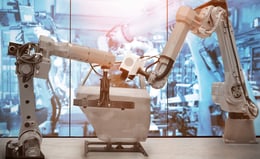5 Surprising Facts About Inventory Management in the Industry 4.0 Era
Brian Hoey - October 30, 2018

Let’s talk about Amazon Go for a moment. The incredibly successful online retailer has recently made headlines with its latest foray into brick and mortar shopping, a series of convenience stores that, notably, don’t feature any human cashiers. Instead, shoppers (all of whom need an Amazon Prime account) use an app on their phones to scan each item they put into their (physical) shopping cart. This is noteworthy for a host of reasons, but let’s look at it from an inventory management perspective. The store is stocked with a considerable number of items, which all need to be replenished as they are sold, and Amazon is able to track the flow of goods out of their stores with no human intervention. Not only that, but they’re able to link each piece of inventory that leaves the store to a particular user account, and then make recommendations to that user based on analytics processes designed to predict future buying behavior.
More than anything, the above acts as proof that inventory management is firmly entering the Industry 4.0 era, with smart, connected technology changing the nature of the entire value chain in terms of visibility and data usability. As inventory management undergoes this transformation alongside Industry 4.0 processes that are more strictly industrial (e.g. production planning), what should supply chain managers in the manufacturing sector know in order to prepare for future changes?
1. In 2015, the global cost of overstocking goods was $470 billion.
And the cost of under-stocking was more than $600 billion. From a supply chain manager’s perspective, it’s easy to see how this could come about. Because most businesses still rely on past demand and past customer behavior to set their expectations for the future, they often plan for demand levels that ultimately diverge significantly from reality. This leads to shortages, or to stock taking up valuable warehouse space unnecessarily, which is not only costly, but organizationally problematic: inventory planners wind up spending a disproportionate amount of their time responding to disruptions, which makes it that much more difficult to drive towards the type of proactive, responsive value chain that could more easily adapt to changing demand realities.
2. But predictive analytics can help mitigate both overstocking and under-stocking.
Imagine you’re in a situation like the one sketched out above. You have enough inventory to meet the expected demand of one of your largest client’s (based on the orders they made during the previous two years), when their business experiences a downturn and their order levels decrease. All of a sudden, you’re sitting on a bunch of unsold stock that’s likely to stay in the warehouse much longer than expected, at great cost to your business. It may seem like there was no way around this disruption—but a robust analytics workflow actually could have mitigated these losses by helping your business to more effectively sense changes in demand in advance. Though the technical requirements for implementing this kind of analytics workflow are high (advanced analytics thrive in environments that provide easy access to operational data, meaning that end-to-end visibility and a reduced number of information silos are ideal), the result can more efficient inventory usage by way of demand forecasts that more accurately reflect future market realities.
3. Industry 4.0 creates cross-functional synergies between inventory management, production planning, and transport logistics.
In the previous fact we alluded to the importance of breaking down data silos, but smart, modern inventory management is increasingly requiring manufacturers to break down planning silos as well. This is where Industry 4.0 comes in: instead of keeping inventory management siloized and separate from other operational workflows, Industry 4.0-enabled businesses can create highly visible digital planning environments, in which disparate functions across the entire value chain have insight into one another’s processes. This means that if, for example, transport planners have a particular method for bundling orders that they're using, inventory planners can stock their warehouses in such a way as to optimize load and unload time, thereby saving time and money. Where, in a non-digitized value chain, these disconnected processes would have been unable to create the sort of synergy described above, Industry 4.0 workflows give cross-functional planners the tools to work together, in this case saving time and money in the wake of a load-unload process that would have otherwise been difficult to optimize across planning silos.
4. Modern manufacturers are implementing S&OE workflows to help align inventory usage with operational planning goals.
One of the most important changes to the way that inventory is managed in the Industry 4.0 era is the emergence of a new planning workflow, dubbed sales & operations execution (S&OE). It’s aim is to bridge the gap between sales & operations planning (S&OP) and day-to-day supply chain operations by making small adjustments to inventory levels and transport plans based on daily and weekly fluctuations in demand. Why is this process just emerging now? Because it requires the integration of real-time information into the supply chain—something that Industry 4.0 has increasingly helped to bring about. In this way, S&OE planners keep longer-term plans on track while providing the rest of the organization with real-time snapshots of their daily supply chain activities. This provides value in a number of ways, which you can read more about here.
5. More than half of businesses plan to update their mobile devices, boosting connectivity and agility.
For an article that started out discussing Amazon Go, this is probably our most thematic fact. Though it covers more industries than just automotive manufacturing or even manufacturing more broadly, it does tell us a lot about the way that inventory management is being rethought. We spoke about connectivity abstractly above, but this fact signals the concrete way in which that connectivity is going to be achieved: smart, connected devices that are designed to simplify and enhance human labor—creating cyber-physical system that ensure accessible digital records of the way stock is being loaded, stored, managed, and unloaded. Like our Amazon Go stores, these modern, device-enabled warehouses will take the guesswork out of tracking goods across the value chain, helping to bring valuable planning clarity to manufacturers who might otherwise find themselves with expensive parts shortages due to low inventory visibility. On some level, visibility has always been at the heart of effective inventory planning, but the technologies that comprise Industry 4.0 are rapidly changing the ways that that visibility is brought about—with human labor being augmented by digital devices and processes, and new IT solutions automating demand sensing and other tasks. As we wade further into the world of the fourth industrial revolution, you can expect these changes to become more and more ingrained in the supply chain. Soon, the Amazon Go model won’t seem so revolutionary anymore.
If you want to learn more get your Guide to Industry 4.0:
LATEST POSTS
- Understand Why Production Planning Needs Specialized Solutions
- Understand Circular Economy in The Manufacturing Industry
- How Can Industry 4.0 IT Integration Be Achieved Smoothly?
- The Significance of Order Sequencing in Discrete Manufacturing
- How to improve your Supply Chain Management: The Power of Control Towers


